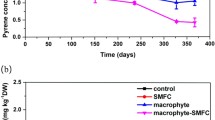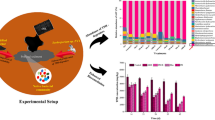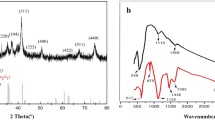Abstract
Purpose
Submerged macrophyte Vallisneria spiralis and sediment microbial fuel cell (SMFC) systems are cost-effective methods for the remediation of polycyclic aromatic hydrocarbon (PAH)–polluted sediments. This study evaluates whether the combination of these two ecological approaches could further improve the removal efficiency of PAHs from sediments and investigates the possible mechanisms of removal.
Materials and methods
Sediments, macrophytes, electrodes, and plexiglass columns were used to construct an experimental microcosm. A 65-day comparative study was performed with six treatments as follows: SMFC without PAH (SMFC); PAH only (PAH); SMFC with PAH (SMFC-PAH); V. spiralis without PAH (macrophyte); V. spiralis with PAH (macrophyte-PAH); V. spiralis with SMFC and PAH (M-SMFC-PAH). Pyrene and phenanthrene were added to raw sediments to obtain initial PAH concentrations of 10 mg kg−1 dry sediment. The monitored parameters were sediment oxidation–reduction potential (ORP); low molecular weight organic acids (LMWOAs) and Fe (II) concentrations in pore water; electron acceptor (sulfate and Fe (III)), humic acid (HA), and PAH concentrations in sediments; and plant morphology and root physiology. High-throughput 16S rRNA gene sequencing was also performed to assist mechanistic understanding.
Results and discussion
The M-SMFC-PAH treatment obtained the highest sediment ORP and PAH removal efficiency. The average ORP level in M-SMFC-PAH was increased by 57.2, 59.1, and 168.4 mV, compared with the SMFC-PAH, macrophyte-PAH, and PAH-only treatments, respectively, with a mean value of 121.7 mV observed during the whole experimental period. The pyrene (phenanthrene) dissipation ratios at the end of the experimental period were 29.1% (35.4%), 45.5% (56.3%), 59.8% (67.3%), and 79.4% (88.2%) for PAH only, SMFC-PAH, macrophyte-PAH, and M-SMFC-PAH treatments, respectively. The highest correlation was observed between PAH concentration and sediment ORP value, in the coupled M-SMFC-PAH system.
Conclusions
Results suggest that the interactions between the anode and rhizosphere of V. spiralis were synergistic during PAH removal. The coexistence of anodic and rhizospheric oxygen loss in sediments had a synergistic effect on PAH degradation. Plant presence facilitated the electrogenic degradation of PAHs. The inhibited growth of V. spiralis due to PAH toxicity was reduced by electrogenesis, thus facilitating the removal of vegetable PAHs from sediments. Coordinated growth of anaerobic and aerobic PAH degrading bacteria on the anode was a key factor in the optimal removal of PAHs in coupled systems.






Similar content being viewed by others
References
Arends JBA, Speeckaert J, Blondeel E, De Vrieze J, Boeckx P, Verstraete W, Rabaey K, Boon N (2014) Greenhouse gas emissions from rice microcosms amended with a plant microbial fuel cell. Appl Microbiol Biotechnol 98:3205–3217
Bhaskaran J, Panneerselvam R (2013) Accelerated reactive oxygen scavenging system and membrane integrity of two Panicum species varying in salt tolerance. Cell Biochem Biophys 67:885–892
Bond DR, Holmes DE, Tender LM, Lovley DR (2002) Electrode-reducing microorganisms that harvest energy from marine sediments. Science 295:483–485
Caporaso JG, Kuczynski J, Stombaugh J, Bittinger K, Bushman FD, Costello EK, Fierer N, Peña AG, Goodrich JK, Gordon JI, Huttley GA, Kelley ST, Knights D, Koenig JE, Ley RE, Lozupone CA, McDonald D, Muegge BD, Pirrung M, Reeder J, Sevinsky JR, Turnbaugh PJ, Walters WA, Widmann J, Yatsunenko T, Zaneveld J, Knight R (2010) QIIME allows analysis of high-throughput community sequencing data. Nat Methods 7:335–336
Chroma L, Mackova M, Kucerova P, Burkhard J, Macek T (2002) Enzymes in plant metabolism of PCBs and PAHs. Acta Biotechnol 22:35–41
Cooney MJ, Roschi E, Marison IW, Comninellis C, von Stockar U (1996) Physiologic studies with the sulfate-reducing bacterium Desulfovibrio desulfuricans: evaluation for use in a biofuel cell. Enzyme Microb Technol 18:358–365
Crespo C, Pozzo T, Karlsson EN, Alvarez MT, Mattiasson B (2012) Caloramator boliviensis sp nov., a thermophilic, ethanol-producing bacterium isolated from a hot spring. Int J Syst Evol Microbiol 62:1679–1686
Ding MN, Shiu HY, Li SL, Lee CK, Wang GM, Wu H, Weiss NO, Young TD, Weiss PS, Wong GCL (2016) Nanoelectronic investigation reveals the electrochemical basis of electrical conductivity in Shewanella and Geobacter. ACS Nano 10:9919–9926
Dunaj SJ, Vallino JJ, Hines ME, Gay M, Kobyljanec C, Rooney-Varga JN (2012) Relationships between soil organic matter, nutrients, bacterial community structure, and the performance of microbial fuel cells. Environ Sci Technol 46:1914–1922
Faithfull NT (2002) Methods in agricultural chemical analysis—a practical handbook. CABI publishers, Wallingford
Fleming EJ, Woyke T, Donatello RA, Kuypers MMM, Sczyrba A, Littmann S, Emerson D (2018) Insights into the fundamental physiology of the uncultured Fe-oxidizing bacterium Leptothrix ochracea. Appl Environ Microbiol 84:e02239–e02217
Frutos FJG, Escolano O, Garcia S, Babin M, Fernandez MD (2010) Bioventing remediation and ecotoxicity evaluation of phenanthrene-contaminated soil. J Hazard Mater 183:806–813
Goud RK, Mohan SV (2013) Prolonged applied potential to anode facilitate selective enrichment of bio-electrochemically active Proteobacteria for mediating electron transfer: microbial dynamics and bio-catalytic analysis. Bioresour Technol 137:160–170
Hamdan HZ, Salam DA, Hari AR, Semerjian L, Saikaly P (2017) Assessment of the performance of SMFCs in the bioremediation of PAHs in contaminated marine sediments under different redox conditions and analysis of the associated microbial communities. Sci Total Environ 575:1453–1461
Haritash AK, Kaushik CP (2009) Biodegradation aspects of polycyclic aromatic hydrocarbons (PAHs): a review. J Hazard Mater 169:1–15
He Y, Chi J (2016) Phytoremediation of sediments polluted with phenanthrene and pyrene by four submerged aquatic plants. J Soils Sediments 16:309–317
Holmes DE, Bond DR, Lovley DR (2004a) Electron transfer by Desulfobulbus propionicus to Fe (III) and graphite electrodes. Appl Environ Microbiol 70:1234–1237
Holmes DE, Bond DR, O'Neill RA, Reimers CE, Tender LR, Lovley DR (2004b) Microbial communities associated with electrodes harvesting electricity from a variety of aquatic sediments. Microb Ecol 48:178–190
Hong SW, Kim HS, Chung TH (2010) Alteration of sediment organic matter in sediment microbial fuel cells. Environ Pollut 158:185–191
Ishii S, Suzuki S, Yamanaka Y, Wu A, Nealson KH, Bretschger O (2017) Population dynamics of electrogenic microbial communities in microbial fuel cells started with three different inoculum sources. Bioelectrochemistry 117:74–82
Jiang S, Lu H, Zhang Q, Liu J, Yan C (2016) Effect of enhanced reactive nitrogen availability on plant-sediment mediated degradation of polycyclic aromatic hydrocarbons in contaminated mangrove sediment. Mar Pollut Bull 110:424–431
Jobelius C, Ruth B, Griebler C, Meckenstock RU, Hollender J, Reineke A, Frimmel FH, Zwiener C (2011) Metabolites indicate hot spots of biodegradation and biogeochemical gradients in a high-resolution monitoring well. Environ Sci Technol 45:474–481
Jouanneau Y, Willison JC, Meyer C, Krivobok S, Chevron N, Besombes JL, Blake G (2005) Stimulation of pyrene mineralization in freshwater sediments by bacterial and plant bioaugmentation. Environ Sci Technol 39:5729–5735
Kanaly RA, Harayama S (2000) Biodegradation of high-molecular-weight polycyclic aromatic hydrocarbons by bacteria. J Bacteriol 182:2059–2067
Kato S, Nakamura R, Kai F, Watanabe K, Hashimoto K (2010) Respiratory interactions of soil bacteria with (semi)conductive iron-oxide minerals. Environ Microbiol 12:3114–3123
Kouzuma A, Kasai T, Nakagawa G, Yamamuro A, Abe T, Watanabe K (2013) Comparative metagenomics of anode-associated microbiomes developed in rice paddy-field microbial fuel cells. PLoS One 8:e77443
Kummel S, Herbst FA, Bahr A, Duarte M, Pieper DH, Jehmlich N, Seifert J, von Bergen M, Bombach P, Richnow HH, Vogt C (2015) Anaerobic naphthalene degradation by sulfate-reducing Desulfobacteraceae from various anoxic aquifers. FEMS Microbiol Ecol 91:fiv006
Li Z, Wrenn BA (2004) Effects of ferric hydroxide on the anaerobic biodegradation kinetics and toxicity of vegetable oil in freshwater sediments. Water Res 38:3859–3868
Li X, Wang X, Zhang Y, Cheng L, Liu J, Li F, Gao B, Zhou Q (2014) Extended petroleum hydrocarbon bioremediation in saline soil using Pt-free multianodes microbial fuel cells. RSC Adv 4:59803–59808
Li JB, Luo CL, Zhang DY, Song MK, Cai XX, Jiang LF, Zhang G (2018) Autochthonous bioaugmentation-modified bacterial diversity of phenanthrene degraders in PAH-contaminated wastewater as revealed by DNA-stable isotope probing. Environ Sci Technol 52:2934–2944
Liu YC, Zhou TT, Zhang J, Xu L, Zhang ZH, Shen QR, Shen B (2009) Molecular characterization of the alkB gene in the thermophilic Geobacillus sp. strain MH-1. Res Microbiol 160:560–566
Luo JM, Li M, Zhou MH, Hu YS (2015) Characterization of a novel strain phylogenetically related to Kocuria rhizophila and its chemical modification to improve performance of microbial fuel cells. Biosens Bioelectron 69:113–120
Luo JM, Wang TT, Li X, Yang YN, Zhou MH, Li M, Yan ZL (2018) Enhancement of bioelectricity generation via heterologous expression of IrrE in Pseudomonas aeruginosa-inoculated MFCs. Biosens Bioelectron 117:23–31
Ma C, Wang YQ, Zhuang L, Huang DY, Zhou SG, Li FB (2011) Anaerobic degradation of phenanthrene by a newly isolated humus-reducing bacterium, Pseudomonas aeruginosa strain PAH-1. J Soils Sediments 11:923–929
McNally DL, Mihelcic JR, Lueking DR (1999) Biodegradation of mixtures of polycyclic aromatic hydrocarbons under aerobic and nitrate reducing conditions. Chemosphere 38:1313–1321
MEPC (Ministry of Environmental Protection of China), WWMAA (Water and wastewater Monitoring and Analysis Association) (2002) Standard Methods for Examination of Water and Wastewater. Chinese Environmental Sciences Press, Beijing
Ni N, Wang F, Song Y, Bian YR, Shi RY, Yang XL, Gu CG, Jiang X (2018) Mechanisms of biochar reducing the bioaccumulation of PAHs in rice from soil: degradation stimulation vs immobilization. Chemosphere 196:288–296
Parke D, Rivelli M, Ornston LN (1985) Chemotaxis to aromatic and hydroaromatic acids: comparison of Bradyrhizobium japonicum and Rhizobium trifolii. J Bacteriol 163:417–422
Popp D, Plugge CM, Kleinsteuber S, Harms H, Strauber H (2017) Inhibitory effect of coumarin on syntrophic fatty acid-oxidizing and methanogenic cultures and biogas reactor microbiomes. Appl Environ Microbiol 83:e00438–e00417
Ramdine G, Fichet D, Louis M, Lemoine S (2012) Polycyclic aromatic hydrocarbons (PAHs) in surface sediment and oysters (Crassostrea rhizophorae) from mangrove of Guadeloupe: levels, bioavailability, and effects. Ecotoxicol Environ Saf 79:80–89
Sabina K, Fayidh MA, Archana G, Sivarajan M, Babuskin S, Babu PAS, Radha KK, Sukumar M (2014) Microbial desalination cell for enhanced biodegradation of waste engine oil using a novel bacterial strain Bacillus subtilis moh3. Environ Technol 35:2194–2203
Salinero KK, Keller K, Feil WS, Feil H, Trong S, Di Bartolo G, Lapidus A (2009) Metabolic analysis of the soil microbe Dechloromonas aromatica str. RCB: indications of a surprisingly complex life-style and cryptic anaerobic pathways for aromatic degradation. BMC Genomics 10:351
Sherafatmand M, Ng HY (2015) Using sediment microbial fuel cells (SMFCs) for bioremediation of polycyclic aromatic hydrocarbons (PAHs). Bioresour Technol 195:122–130
Smith KE, Schwab AP, Banks MK (2008) Dissipation of PAHs in saturated, dredged sediments: a field trial. Chemosphere 72:1614–1619
Stach JEM, Burns RG (2004) Enrichment versus biofilm culture: a functional and phylogenetic comparison of polycyclic aromatic hydrocarbon-degrading microbial communities. Environ Microbiol 4:169–182
Sun RX, Sun Y, Li QX, Zheng XB, Luo XJ, Mai BX (2018) Polycyclic aromatic hydrocarbons in sediments and marine organisms: implications of anthropogenic effects on the coastal environment. Sci Total Environ 640-641:264–272
Tang ZC (1999) Experimental guide of modern plant physiology. Science Press, Beijing
Timmers RA, Strik DPBTB, Arampatzoglou C, Buisman CJN, Hamelers HVM (2012) Rhizosphere anode model explains high oxygen levels during operation of a Glyceria maxima PMFC. Bioresour Technol 108:60–67
Toczylowska-Maminska R, Szymona K, Krol P, Gliniewicz K, Pielech-Przybylska K, Kloch M, Logan BE (2018) Evolving microbial communities in cellulose-fed microbial fuel cell. Energies 11:124
USEPA (1996) Soxhlet extraction. US Environmental Protection Agency, Washington DC
Venkidusamy K, Megharaj M, Marzorati M, Lockington R, Naidu R (2016) Enhanced removal of petroleum hydrocarbons using a bioelectrochemical remediation system with pre-cultured anodes. Sci Total Environ 539:61–69
Wang YY, Fang L, Lin L, Luan TG, Tam NFY (2014) Effects of low molecular-weight organic acids and dehydrogenase activity in rhizosphere sediments of mangrove plants on phytoremediation of polycyclic aromatic hydrocarbons. Chemosphere 99:152–159
Wang BB, Teng Y, Xu YF, Chen W, Ren WJ, Li Y, Christie P, Luo YM (2018a) Effects of mixed soil microbiomes on pyrene removal and the response of the soil microorganisms. Sci Total Environ 640-641:9–17
Wang ZC, Liu SS, Bu ZJ, Wang SZ (2018b) Degradation of polycyclic aromatic hydrocarbons (PAHs) during Sphagnum litters decay. Environ Sci Pollut Res 25:18642–18650
Winderl C, Penning H, Netzer F, Von Meckenstock RU, Lueders T (2010) DNA-SIP identifies sulfate-reducing Clostridia as important toluene degraders in tar-oil-contaminated aquifer sediment. ISME J 4:1314–1325
Xiao M, Wu FC (2014) A review of environmental characteristics and effects of low-molecular weight organic acids in the surface ecosystem. J Environ Sci 26:935–954
Xing XG, Ding SM, Liu L, Chen MS, Yan WM, Zhao LP, Zhang CS (2018) Direct evidence for the enhanced acquisition of phosphorus in the rhizosphere of aquatic plants: a case study on Vallisneria natans. Sci Total Environ 616-617:386–396
Xu M, He Z, Zhang Q, Liu J, Guo J, Sun G, Zhou J (2015) Responses of aromatic-degrading microbial communities to elevated nitrate in sediments. Environ Sci Technol 49:12422–12431
Xu P, Xiao ER, Xu D, Zhou Y, He F, Liu BY, Zeng L, Wu ZB (2017) Internal nitrogen removal from sediments by the hybrid system of microbial fuel cells and submerged aquatic plants. PLoS One 12:e0172757
Yan ZS, Guo HY, Song TS, Hu Y, Jiang HL (2011) Tolerance and remedial function of rooted submersed macrophyte Vallisneria spiralis to phenanthrene in freshwater sediments. Ecol Eng 37:123–127
Yan ZS, Song N, Cai HY, Tay JH, Jiang HL (2012) Enhanced degradation of phenanthrene and pyrene in freshwater sediments by combined employment of sediment microbial fuel cell and amorphous ferric hydroxide. J Hazard Mater 199:217–225
Yan ZS, Jiang HL, Cai HY, Zhou YL, Krumholz LR (2015) Complex interactions between the macrophyte Acorus calamus and microbial fuel cells during pyrene and benzo[a]pyrene degradation in sediments. Sci Rep 5:10709
Yan ZS, He YH, Cai HY, Van Nostrand JD, He ZL, Zhou JZ, Krumholz LR, Jiang HL (2017) Interconnection of key microbial functional genes for enhanced benzo[a]pyrene biodegradation in sediments by microbial electrochemistry. Environ Sci Technol 51:8519–8529
Yang Y, Lu Z, Lin X, Xia C, Sun G, Lian Y, Xu M (2015) Enhancing the bioremediation by harvesting electricity from the heavily contaminated sediments. Bioresour Technol 179:615–618
You LX, Liu LD, Xiao Y, Dai YF, Chen BL, Jiang YX, Zhao F (2018) Flavins mediate extracellular electron transfer in gram-positive Bacillus megaterium strain LLD-1. Bioelectrochemistry 119:196–201
Zhang Z, Lo IMC (2015) Biostimulation of petroleum-hydrocarbon-contaminated marine sediment with co-substrate: involved metabolic process and microbial community. Appl Environ Microbiol 99:5683–5696
Zhang M, Zhu LZ (2009) Sorption of polycyclic aromatic hydrocarbons to carbohydrates and lipids of ryegrass root and implications for a sorption prediction model. Environ Sci Technol 43:2740–2745
Zhao JK, Li XM, Ai GM, Deng Y, Liu SJ, Jiang CY (2016) Reconstruction of metabolic networks in a fluoranthene-degrading enrichments from polycyclic aromatic hydrocarbon polluted soil. J Hazard Mater 318:90–98
Zhao YK, Li ZL, Ma JC, Yun H, Qi MY, Ma XD, Wang H, Wang AJ, Liang B (2018) Enhanced bioelectroremediation of a complexly contaminated river sediment through stimulating electroactive degraders with methanol supply. J Hazard Mater 349:168–176
Zhou L, Deng D, Zhang D, Chen Q, Kang J, Fan N, Liu Y (2016a) Microbial electricity generation and isolation of exoelectrogenic bacteria based on petroleum hydrocarbon-contaminated soil. Electroanalysis 28:1510–1516
Zhou YL, Wu HF, Yan ZS, Cai HY, Jiang HL (2016b) The enhanced survival of submerged macrophyte Potamogeton malaianus by sediment microbial fuel cells. Ecol Eng 87:254–262
Ziels RM, Beck DAC, Stensel HD (2017) Long-chain fatty acid feeding frequency in anaerobic codigestion impacts syntrophic community structure and biokinetics. Water Res 117:218–229
Acknowledgements
This work was financially supported by the National Key Research and Development Plan of China (2016YFC0500403-03) and the Science and Technology Service Network Initiative of the Chinese Academy of Sciences (KFJ-STS-ZDTP-038). We would like to thank Dr. Lin Qingwei, Dr. Min Fenli, and Mr. Dai Zhigang for their assistance.
Author information
Authors and Affiliations
Corresponding author
Additional information
Responsible editor: Terrence H. Bell
Publisher’s note
Springer Nature remains neutral with regard to jurisdictional claims in published maps and institutional affiliations.
Electronic supplementary material
Fig. S1
Variation of the pore water concentrations of (a) acetic acid, (b) oxalic acid, (c) citric acid, (d) malic acid, and (e) Fe (II) in pore water over time. All data are shown as the mean value with standard deviation (n = 6 at day 0 to day 24; n = 3 at day 24 to day 64) (PNG 472 kb)
Fig. S2
Taxonomic classification of the top 20 bacterial sequences observed in communities present on anodes (SMFC, SMFC-PAH, M-SMFC-PAH) in rhizospheric sediments (macrophyte, macrophyte-PAH) and sediments (PAH) at the (a) phylum and (b) class levels (PNG 280 kb)
Fig. S3
Linear regression analysis between PAH concentration and sediment ORP level for all six treatments (PNG 202 kb)
Rights and permissions
About this article
Cite this article
Xu, P., Xiao, E., Zeng, L. et al. Enhanced degradation of pyrene and phenanthrene in sediments through synergistic interactions between microbial fuel cells and submerged macrophyte Vallisneria spiralis. J Soils Sediments 19, 2634–2649 (2019). https://doi.org/10.1007/s11368-019-02247-0
Received:
Accepted:
Published:
Issue Date:
DOI: https://doi.org/10.1007/s11368-019-02247-0




